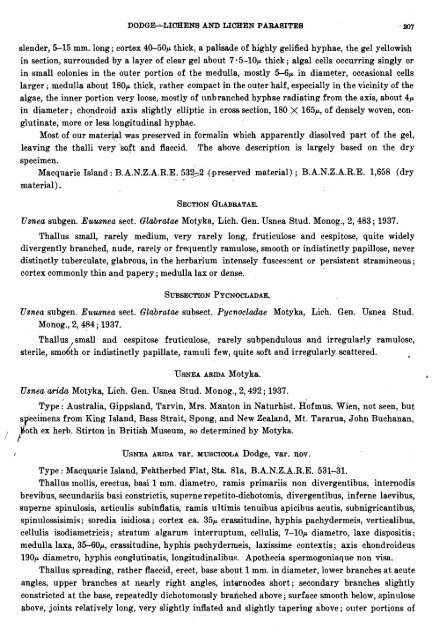Create successful ePaper yourself
Turn your PDF publications into a flip-book with our unique Google optimized e-Paper software.
DODGE-LIGHENB <strong>AND</strong> <strong>LICHEN</strong> <strong>PARASITES</strong> 207<br />
slender, 5-15 mm. long ; cortex 40-50p thick, a palisade of highly gelified hyphae, the gel yellowish<br />
in section, surrounded by a layer of clear gel about 7-5-lop thick; algal cells occurring singly or<br />
in small colonies in the outer portion of the medulla, mostly 5-6p in diameter, occasional cells<br />
larger ; medulla about 180p thick, rather compact in the outer half, especially in the vicinity of the<br />
algae, the inner portion very loose, mostly of nnbranched hyphae radiating from the axis, about 4,~<br />
in diameter; chondroid axis slightly elliptic in cross section, 180 X 165p, of densely woven, conglutinate,<br />
more or less longitudinal hyphae.<br />
Most of our material was preserved in formalin which apparently dissolved part of the gel,<br />
leaving the thalli very hft and flaccid. The above description is largely based on the dry<br />
specimen.<br />
Macquarie Island : B.A.N.Z.A.R.E. 5323 -(-preserved material) ; B.A.N.Z.A.R.E. 1,658 (dry<br />
. -<br />
material).<br />
Usnea subgen. Euwnea sect. Glabratae Motyka, Lich. Gen. Usnea ~tud.'~ono~., 2,483; 1937.<br />
Thallus small, rarely medium, very rarely long, fruticulose and cespitose, quite widely<br />
divergently branched, nude, rarely or frequently ramulose, smooth or indistinctly papillose, never<br />
distinctly tuberculate, glabrous, in the herbarium intensely fusces2ent or persistent stramineous;<br />
cortex commonly thin and papery; medulla lax or dense.<br />
Usnea subgen. Ez~wnea sect. Clab~a~tae subsect. Pycnocladae Motyka, Lich. Glen. Usnea Stud.<br />
Monog., 2,484 ; 1937.<br />
Thallus small and cespitose fruticulose, rarely subpendulous and irregularly ramulose,<br />
,'<br />
sterile, smo5th or indistinctly papillate, ramuli few, quite soft and irregularly scattered. I<br />
USNEA ARIDA Motyka.<br />
Usnea arida Motyka, Lich. Gen. IJsnea Stud. Monog., 2,492 ; 1937.<br />
Type :Australia, Gippsland, Tarvin, Mrs. Manton in Naturhist. ~hfmus. Wien, not seen, but<br />
s bcimens from King Island, Bass Strait, Spong, and New Zealand, Mt. Tararua, John Buchanan,<br />
B<br />
goth ex herb. Stirton in British Museum, so determined by Motyka.<br />
! I:<br />
/ USNEA ARIDA var. .~uscrcn~a Dodge, var. nov.<br />
Type : Macquarie Island, Fehtherbed Flat, Sta. 81a, B.A.N.Z.A.R.E. 531-31.<br />
Thallus mollis, erectus, basi 1 mm. diametro, ramis primariis non divergentibus, internodis<br />
brevibus, secundariis basi constrictis, superne repetito-dichotomis, divergentibus, inferne laevibus,<br />
superne spinulosis, articulis subinflatis, ramis ultimis tenuibus apicibus acutis, subnigricantibus,<br />
spinulossisimis; soredia isidiosa ; cortex ca. 35p crassitudine, hyphis pachydermeis, verticalibus,<br />
cellulis isodiametricis; stratum algarum interruptum, cellulis, 7-locL diametro, laxe dispositis;<br />
medulla laxa, 35-60p, crassitudine, hyphis pachydermeis, laxissime contextis ; axis chondroideus<br />
190p diametro, hyphis conglutinatis, longitudinalibux. Apothecia spermogoniaqua non visa.<br />
Thallus spreading, rather flaccid, erect, base about 1 mm. in diameter, lower branches at acute<br />
angles, upper branches at nearly right angles, intqrnodes short; secondary branches slightly<br />
constricted at the base, repeatedly dichotomously brahched above; surface smooth below, spinulose<br />
above, joints relatively long, very slightly inflated and slightly tapering above ; outer portions of

















